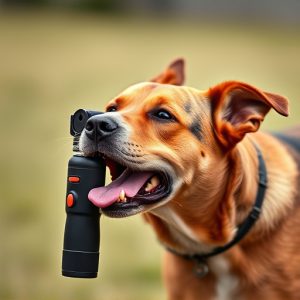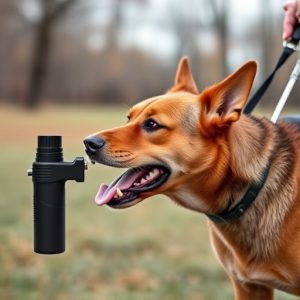Mace Dog Repellent Spray: Legal Use, Effectiveness, and Safe Alternatives
Mace Dog Repellent Spray offers effective non-lethal animal control solutions with its impressive 4…….
Mace Dog Repellent Spray offers effective non-lethal animal control solutions with its impressive 4 sq ft coverage, ideal for urban areas. However, its usage requires strict adherence to local regulations and safety precautions due to varying legalities across regions. Always consult authorities, follow manufacturer instructions, and be responsible in applying the spray to maintain safe distances and avoid harm.
In many regions, animal control spray, particularly mace dog repellent, is a legal tool for managing aggressive or stray animals. However, understanding its legal use and safe application is paramount due to regional variations in regulations. This article navigates the intricate web of laws surrounding animal control spray, delving into specific considerations like mace dog repellent spray coverage, effective techniques, safety measures, and exploring alternative non-lethal methods for responsible animal control.
- Understanding Legal Frameworks: Regional Variations in Animal Control Spray Regulations
- Mace Dog Repellent Spray: Effective Coverage and Application Techniques
- Safe Use and Safety Measures: Ensuring Responsibility and Minimizing Risks
- Alternative Solutions and Their Efficacy: Exploring Non-Lethal Methods for Animal Control
Understanding Legal Frameworks: Regional Variations in Animal Control Spray Regulations
Animal control sprays, particularly those designed for dog deterrents like mace, operate under a stringent legal framework that varies significantly from region to region. What’s legal in one area might be strictly prohibited in another. These variations stem from differing cultural perspectives on animal welfare and public safety. For instance, urban areas often have stricter regulations due to higher population density and potential for misuse, while rural regions may have more lenient rules.
Understanding these regional nuances is crucial when considering the purchase or use of animal control sprays. The coverage area – how much space a single spray can effectively protect – also plays into legal considerations. Wider coverage implies greater responsibility, as it increases the likelihood of off-target effects on non-endangered species or humans. Always check local ordinances and consult with authorities to ensure compliance, especially when dealing with commercial applications of dog repellent sprays.
Mace Dog Repellent Spray: Effective Coverage and Application Techniques
The Mace Dog Repellent Spray is a popular choice for those seeking an effective, non-lethal way to deter dog intrusions. One of its key selling points is the impressive Mace Dog Repellent Spray Coverage. This spray is designed to create a protective barrier that can cover up to 4 square feet per burst, ensuring broad protection against unwanted canine visitors.
Application techniques are crucial for maximizing its effectiveness. Users should aim for a direct stream or fine mist, focusing on areas where dogs typically enter or rest, such as windowsills, doors, and patios. It’s recommended to reapply the spray every 7-14 days or after heavy rain to maintain optimal performance. Regular use will reinforce the scent, creating a lasting deterrent that keeps dogs at bay.
Safe Use and Safety Measures: Ensuring Responsibility and Minimizing Risks
When using animal control spray, such as Mace Dog Repellent Spray, it’s crucial to prioritize safety and responsibility. Always read and follow the manufacturer’s instructions for proper application to ensure minimal risk to both humans and animals. Wear protective gear, including gloves and eye protection, to shield yourself from potential splashes or inhalation of the spray. Keep the spray out of reach of children and pets, storing it in a secure location. In case of accidental exposure, have a clear understanding of immediate decontamination procedures.
The range of coverage is an essential factor to consider with dog repellent sprays like Mace. Understanding how far the spray can reach allows users to maintain a safe distance, reducing potential harm to themselves and others. Effective coverage ensures that the spray effectively deterrs dogs without unnecessarily endangering individuals nearby. Responsible use involves recognizing the spray’s limitations and adjusting one’s position accordingly, especially in areas where pets or children might be present.
Alternative Solutions and Their Efficacy: Exploring Non-Lethal Methods for Animal Control
In addressing animal control, it’s crucial to explore non-lethal methods that offer effective and humane solutions. Traditional approaches often involve lethal measures, but there are alternative strategies gaining traction, especially in urban areas where coexistence with wildlife is essential. One such tool is Mace dog repellent spray, known for its swift action and targeted coverage. This non-lethal option is particularly effective against aggressive dogs, providing a safe way to deter potential attacks without causing harm.
Mace dog repellent sprays create a temporary but powerful barrier, using specialized formulations that disrupt an animal’s sense of smell or cause mild irritation. This disrupts their behavior patterns and encourages them to avoid the treated area. Unlike other repellents, Mace brands are designed for specific applications, ensuring optimal coverage and effectiveness. Their range of products caters to various needs, from protecting individuals in remote areas to managing stray dog populations in urban settings, thus offering a practical solution with minimal environmental impact.
In light of the varying legal frameworks across regions regarding animal control spray, understanding the specific regulations and responsible usage is paramount. The Mace Dog Repellent Spray stands out for its effective coverage, but proper application techniques are crucial to ensure safety and minimize risks. While non-lethal alternatives exist, exploring their efficacy alongside traditional methods offers a well-rounded approach to managing animal populations responsibly. By adhering to safe use practices and staying informed about local laws, individuals can contribute to humane and effective animal control strategies.


